Clutch Shoes
Clutch shoes are the heart of the clutch and allow a lot of room for
altering clutch performance. The mass, size, number, and installation
can all change when and how hard a clutch engages.
A lighter clutch shoe will cause the clutch to engage at a higher RPM. Since your nitro engine is timed to produce its power at a
high RPM range, the later your clutch engages and the more bottom end
power your vehicle will have. Although light clutch shoes offer
increased bottom end power, it makes your car harder to drive on
low-traction surfaces. Basically, a lighter shoe makes the car feel
like your engine is tuned with a slightly leaner bottom end, offering
a harder acceleration out of the turn. This setting is preferred on
high-traction surfaces and tight courses where quick acceleration is
important.
The heavier your clutch shoes are, the earlier your clutch will
engage. A clutch with a heavy shoe will have less power while in the
low-RPM range, but your vehicle will be easier to drive. If you are
racing on a low-traction surface with large, sweeping corners, a
slightly heavier clutch shoe is for you.
You can alter the mass of your shoes on your own to change the timing
of engagement. If you want your clutch to engage later, you can remove
a bit of mass by removing some material. Depending on the clutch, you
can either drill a hole in the top of the shoe, cut a small piece of
material away from the trailing end of the shoe, or remove some
material from the back of the shoe. You can't really add mass to a
clutch shoe, so if you want your clutch to engage earlier than the
stock clutch allows, you will have to turn to clutch springs (which
will be explained next) to do your fine tuning. Don't go too crazy
with the hobby knife; if you go too light, the car may be difficult to
drive or the clutch might not engage at all. However, don't be afraid
to experiment. Clutch shoes are relatively inexpensive, so a few cuts
won't kill you while you are searching for that perfect clutch setup.
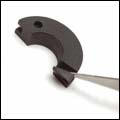
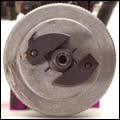
Another way to adjust your clutch engagement point is to alter the
mounting point of the shoe and thus the leverage. Companies such as
HPI and Traxxas offer a few clutch shoe mounting hole choices allowing
clutch tuning without having to alter shoe mass or change clutch
spring rates. When tuning with mounting holes, the closer the pin is
to the center of the shoe, the later the clutch will engage since
there is less leverage. Moving the mounting hole closer to the center
has the same effect as removing mass from the shoe, but the mounting
hole change will allow you to go back to your original setting, while
mass removal will not without installing a new set of shoes.
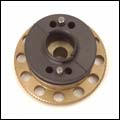
The number of clutch shoes used can also alter clutch performance.
Generally speaking, the more shoes you use, the more surface area your
clutch will have, reducing slippage and making your clutch feel more
consistent. Most manufacturers utilize a two-shoe clutch design while
high-performance clutches (like the Monster GT) usually have three
or four shoes.
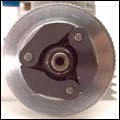
What Does A Clutch Do?
The basic job of a clutch is to connect (and disconnect) your
engine's output shaft to the transmission, and in turn, to the
wheels of your car. The perfect clutch will both engage and
disengage at just the right time to allow maximum power transfer,
ease of driving, minimal slippage, and quick disengagement.
Most people only think of clutch characteristics with regards to
engaging and overlook the important task of disengaging. If your
clutch doesn't disengage properly, you could get "run-on" into a
turn, a situation that occurs when a clutch doesn't disengage when
the throttle is released, forcing the vehicle to carry too much
speed into a turn. At low RPM, your clutch should disengage to allow
your vehicle to slow down or come to a complete stop without
stalling your engine.
Clutches work by following one of the simplest laws of physics. Once
an engine reaches a certain RPM, the centrifugal force subjected
onto the clutch shoes overcome the holding power of the clutch
springs and the shoes are forced outwards against the walls of the
clutch bell. The friction between the clutch shoes and the clutch
bell causes the clutch bell to rotate at the same rate as the
engine's crankshaft and spin the vehicle's transmission and wheels.
Clutch Springs
Just like the mass of a clutch shoe can alter when a clutch engages,
the rate of a clutch spring can affect engagement to the same degree.
A heavier clutch spring does exactly the opposite of a heavy clutch
shoe. Heavy clutch springs cause the clutch to engage later and deeper
into the power band of the engine. This makes for a "snappy" feel on
the bottom end but makes the car harder to drive, especially on
low-traction surfaces. A heavy clutch spring makes your car accelerate
very quickly, but it is not always the best setting for drivers with a
heavy throttle finger. One of the main advantages to heavier clutch
springs are that they allow a slightly higher idle to be set since the
clutch won't engage until a higher RPM. A slightly
higher idle will make your engine more reliable while at a standstill,
like during pit stops or at the start of a race.
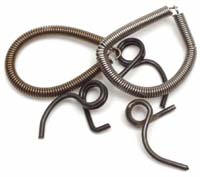
Soft clutch springs work the same way as a heavy clutch shoe in that
your clutch will engage early, offering less bottom end power but
making the car easier to drive on low-traction surfaces.
Clutch springs can be very temperamental and require continuous
attention to ensure they are working properly. A broken clutch spring
will end your race in a second since a broken spring will not allow
the clutch to disengage, causing your engine to "flame out" every time
you stop your car or slow it down through a low-speed turn. You should
also replace your clutch springs on a normal basis to make sure they
haven't weakened with age. A once-firm spring could become softer as
it gets older, which would alter the clutch settings that may have
worked well in the beginning.
There are a couple of signs to look for that may tip you off that you
are having clutch spring problems. If your wheels rotate as soon as
your engine starts, your springs are either too soft, worn out, or one
or more of the clutch springs are broken (It could also be melted
clutch shoes or seized clutch bearings.) The same problem is
responsible for a car that cannot remain stationary while the wheels
are on the ground (assuming the engine's idle is set properly). If
this happens, you should immediately remove your clutch assembly and
examine it closer for damage or wear.
ALUMINUM SHOES
Wave of the Future?
Clutch shoes CNC-machined out of aluminum seem to be one of the
hottest items in the nitro scene lately. Why is that? Maybe it has
to do with the fact that they last exceptionally longer then
conventional shoes. It may also be that they offer consistent
performance without the worry of melting. Or it could be the reduced
mass and stronger engagement. The one thing that it definitely isn't
is the increased cost of use and the excessive wear on clutch bells,
but if all-out performance is what you are looking for, I guess this
doesn't matter much.
If the extra money required for the initial investment and the
increased wear on your clutch bell are not issues, then you may be
in the market for aluminum clutch shoes. Money aside, the increased
performance of an aluminum clutch shoe seems like it is the way to
go. A longer-lasting shoe, more consistent performance, and a harder
grab make aluminum the wave of the future for competitive nitro
racing.
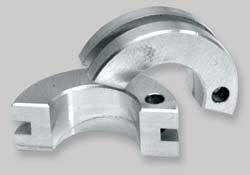
GET THE SHAFT! SG or Pilot that is...
The vehicle that your engine and clutch are to be installed in usually
determines whether you should install an SG or pilot shaft, but
generally speaking, both types will work in any car with the proper
additional parts. There is an argument that an SG shaft will run truer
as compared to a separate pilot shaft since the clutch shaft is one
piece along with the crank shaft, but for the majority of users, the
differences are so minimal that no noticeable performance would be
lost or gained with either setup.
Regardless of the type of shaft you are using, it is very important
that the pilot shaft or clutch nut is secure. Use blue thread-locking
compound (There is never a reason to use permanent-red thread lock in
this hobby.) and a strong twist of your wrench to ensure all of your
clutch bits stay where they belong.

Clutch Bells
When choosing a clutch bell, the most important variable is the number
of teeth on it. You need a clutch bell that will offer the desired
gear ratio. You should consider a few other performance
characteristics of clutch bells. The best clutch bell designs are made
of hardened and also have cooling holes to help dissipate heat and
reduce mass. It is important to have a light clutch bell so it can
accelerate and decelerate quickly as the clutch assembly does its job.
Another area of the clutch bell vital to importance is the bearing
mount, type and size. The best style of bearing to use is the ball
bearing, and the larger they are, the better.
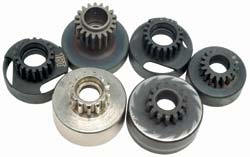
Flywheels
The mass of your flywheel plays a role in acceleration and idling
characteristics. Generally speaking, a low-mass flywheel will allow
your engine to be more agile in that it can accelerate and decelerate
more quickly. This helps to increase acceleration on the track and
makes your vehicle more responsive. A heavy flywheel causes your
engine to lose some responsiveness but makes your idle more reliable
because of the increased momentum. A heavy flywheel will also make
your car less erratic while accelerating and easier to drive.
Some flywheels are vented or have a small fan machined into them. A
vented flywheel serves two purposes: it reduces mass by removing
material from within the flywheel and it also increases the flow of
air across the engine's crankcase to help cooling. You probably won't
notice a major difference after installing a vented flywheel, but the
theory is there and should offer a slight increase in performance.
The type of material and the way your flywheel is manufactured are
important. Most RTR or kit-style flywheels are made from cast
aluminum. This type of manufacturing produces a weak flywheel.
Flywheels don't really need to be strong themselves, but the clutch
shoe pins that are press-fitted into them should be secure. A machined
flywheel will offer a much more secure set of clutch shoe pins as
compared to a cast flywheel, so if you are stuck with cast, once your
pocketbook allows it, upgrade to a machined one.
Get OFF the FREAKIN' THROTTLE
Cowboy!
Other than normal wear and tear on your clutch parts, the only other
way to damage a clutch (as in melt the shoes) is by remaining on the
throttle when the wheels can't rotate. This is a problem that many
beginners have when their vehicle is stuck up against a wall and
they continue applying throttle. If your engine is rotating at a
high RPM and your wheels and transmission cannot rotate, then the
friction between the clutch shoes and clutch bell will turn into
heat and melt the shoes. If your vehicle is ever stuck in a position
where the wheels cannot rotate, get off the throttle until your car
is back in the position where the wheels can rotate freely, and
you'll help to keep your clutch in top condition.
Clutch Bell Bearings
There are two main types of clutch bearings. There are caged roller
bearings and sealed ball bearings. Caged roller bearings will work,
but the nature of their design makes them less reliable since they can
melt and their tolerances are much lower, causing excessive slop. Your
best bet is to use a high-quality set of sealed ball bearings, and
size does matter. The larger the bearing, the better. Some clutches
use a 5 mm x 8 mm bearing while most high performance clutches use a
larger 5 mm x 10 mm. The thicker races and larger balls of the bigger
bearings make them much more reliable, and reliability is a major
issue when it comes to clutch bearings. Outside of your engine, the
clutch bearings spin at the highest RPM of any area on the car, and
they are also subjected to the most heat. For this reason, it is
important to use high-quality, large bearings and replace them on a
regular basis to ensure they are in good shape. A damaged clutch
bearing will usually mean that the clutch will lock up, and if you
bring your vehicle to a complete stop, your engine will stall.
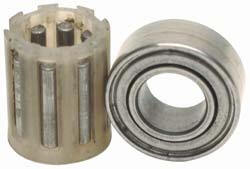

Clutch Maintenance
Maintaining your clutch is rather easy, as long as you do it on a
regular basis. First, completely disassemble your clutch and examine
the parts. Replace any parts that are excessively worn, like clutch
shoes, springs, bearings, and the clutch bell. Sometimes you can clean
up some of the existing parts. Clutch bells, for example, can be
brought back to life by using some very fine sandpaper to clean away
any built-up crap from the clutch shoe contact area. You can remove
the glaze on the contact patch of the clutch shoe as well with some
very fine sandpaper. A good cleaning is in order as well. Remove all
of the built-up carbon and debris by spraying every part of the clutch
with contact cleaner.
When it comes to things like the clutch springs, you are generally
better to just replace them. Clutch springs only cost a few dollars
and begin to weaken as soon as you start using them. Fresh springs
will ensure that they don't become too soft or break during use. Ball
bearings fall into the same sort of category as clutch springs. You
are usually best to replace them if they seem worn at all, since the
stresses on clutch bearings are so huge. If you decide that it isn't
time to replace your bearings, you can simply clean them with contact
cleaner and relubricate them. Be careful not to use too much oil or
too light of an oil that could leak from the ball bearing and onto the
clutch shoe, causing slippage between the shoes and bell.
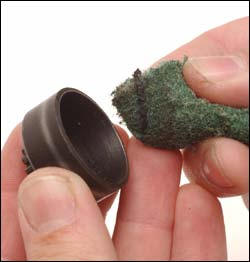
Shimming And End Play
Don't just slap your clutch parts onto the shaft and install the
retaining screw. Take some time to properly shim your clutch for
maximum performance. You don't want your clutch end play to be too
tight and binding, but you don't want excessive slop either. You
ultimately want the least amount of end play while still maintaining a
tight fit. This means that you should be able to move your clutch bell
forward and back slightly, maybe the thickness of two pieces of paper.
It is also wise to install a shim both before and after your clutch
bell and bearing are installed.
This ensures that the shield and outer race of the bearing will not
rub against the clutch nut or screw head, which could cause excessive
drag and heat.
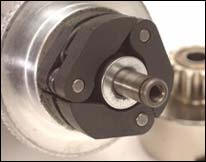
Screws Or E-Clips?
It is common for clutch bell assemblies to be retained onto the pilot
shaft with either an e-clip or a screw. Wherever possible, it is
better to use a screw with some blue thread-locking compound to hold
your clutch together. If you have no choice and you must use an e-clip
for the assembly, then apply a small drop of thread lock or silicone
on the E-clip to prevent it from rotating or popping off of the shaft.
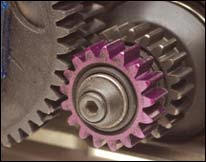
Closing
There you have it: all you've ever wanted to know about clutches. Tune
your clutch to drive the car the way you want it driven, and keep this
piece of machinery in top shape, and your super power plant will push
your high-end chassis around the track for hours with no trouble at
all.
Note from Chevy-SS: This clutch tuning page is
"borrowed" from the Xtreme RC Cars folks and is a great reason to
subscribe to their mag (I do)!
![]()